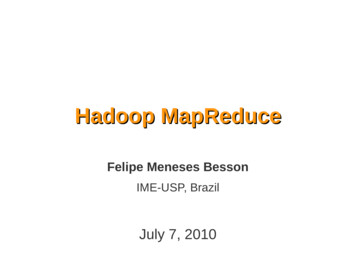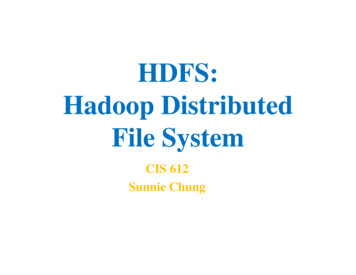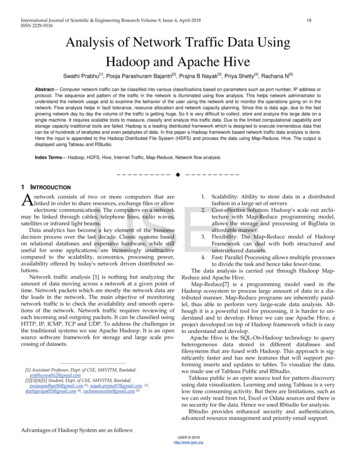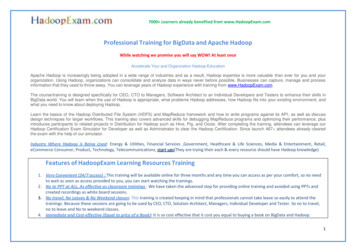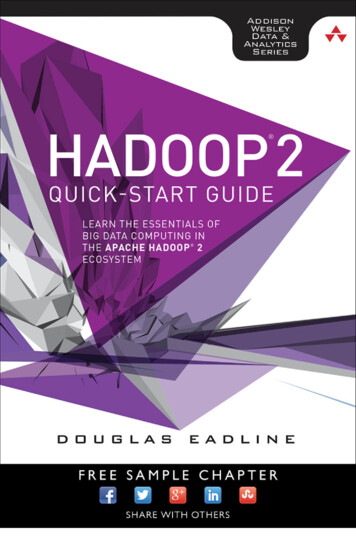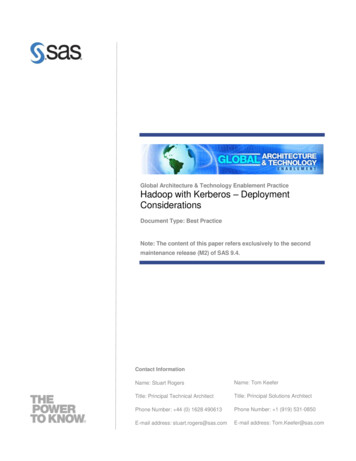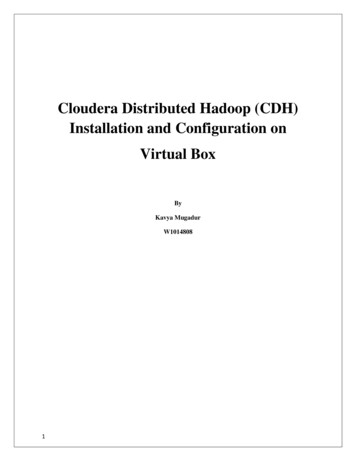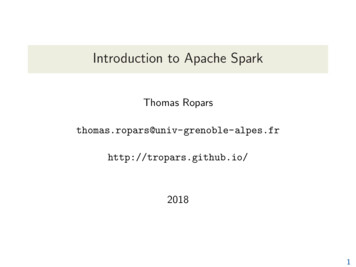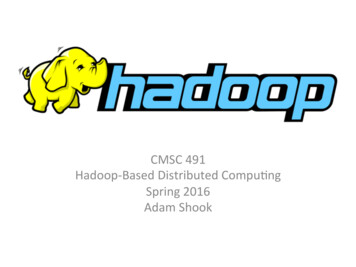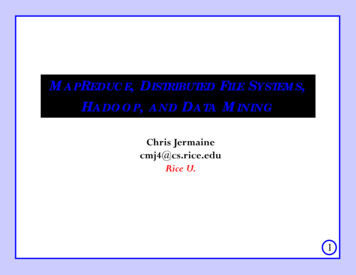
Transcription
MAPREDUCE, DISTRIBUTED FILE SYSTEMS,HADOOP, AND DATA MININGChris Jermainecmj4@cs.rice.eduRice U.1
The Plan for the Next Two Days1.Start with an intro to MapReduce and Hadoop— Then have an activity where you will set up your own Hadoop cluster— Your cluster will be on machines rented from Amazon’s EC2 service2.Then an overview of writing MapReduce programs— Then have an activity where you will write a simple MapReduce code3.Overview of some “data mining” algs for “big data”— Then you will implement a simple algorithm (KMeans clustering) for a singlemachine4.Talk about how this alg could be implemented over MapReduce— Then use your single-machine imp. as a basis for a MapReduce imp.5.Implement one more algorithm over MapReduce— “KNN” classification6.Finish up with a brief discussion of the Mahout package2
10 Years Ago. Say you had a “big” data set, wanted general purpose platform toanalyze it— Analysis: report generation, customer profiling, statistical modelling, etc. What do I mean by “big”?— Too large to fit in aggregate RAM of a standard distributed/parallel system Big is perhaps 100GB in 2002, 10TB 2012 (all the way up todozens of PB) Key: “too large to fit in aggregate RAM”— Generally rules out the classic HPC paradigm— HPC is generally unconcerned with secondary storage— Plus, what happens when the power goes out?3
Hardware: Agreement on “Shared Nothing” Store/analyze data on a large number of commodity machines Local, non-shared storage attached to each of them Only link is via a LAN “Shared nothing” refers to no sharing of RAM, storage Why preferred?— Inexpensive: built out of commodity components (same stuff as in desktop PCs)— You are leveraging price/tech wars among Dell, HP, Intel, AMD, etc.— Compute resources scales nearly linearly with — Contrast this to a shared RAM machine with uniform memory access4
But What About the Software? 10 years ago, you’d have two primary options— Put your data into an SQL database, or— Roll your own software stack to perform your analysis5
Clearly, Building Own Software Not Desirable Costly, time consuming— A 10M software feature might eat up most of the IT budget for a single firm— But Oracle can spread those costs across 100K customers Requires expertise not always found in house Risky: high potential for failure6
But People Not Happy With SQL Databases Also quite expensive: even today, pay 10K to 250K/year/TB Performance often unpredictable, or just flat out poor— Only now are there systems that mortals can get to work in TB range In 2004, not a lot of options for commodity shared nothing Software insanely complicated to use correctly— Hundreds or even thousands of “knobs” to turn Software stack too big/deep, not possible to unbundle— If you are doing analysis, ACID not important— And yet, you pay for it ( , complexity, performance) Difficult to put un- or semi-structured data into an SQL DB— How does an archive of 10M emails get put into a set of relations?7
And, Many People Just Don’t Like SQL It is “declarative”— In some ways, very nice, since parallelism is implicit— But user doesn’t really know what’s happening under the hood. people don’t like Also, not easy/natural to specify important computations— Such as Google’s PageRank, or rule mining, or data clustering, etc.8
By Early-Mid 2000’s. The Internet companies (Google, Yahoo!, etc.).— .had some of the largest databases in the world But they had never used classical SQL databases for webscaledata How’d they deal with all of the data they had to analyze?— Many ways— But paradigm with most widespread impact was MapReduce— First described in a 2004 academic paper, appeared in OSDI— Easy html9
What Is MapReduce? It is a simple data processing paradigm To process a data set, you have two pieces of user-supplied code:— A map code— And a reduce code These are run (potentially over a large compute cluster) usingthree data processing phases— A map phase— A shuffle phase— And a reduce phase10
The Map Phase Assume that the input data are stored in a huge fileThis file contains a simple list of pairs of type (key1,value1) And assume we have a user-supplied function of the formmap (key1,value1) That outputs a list of pairs of the form (key2, value2) In the map phase of the MapReduce computation— this map function is called for every record in the input data set— Instances of map run in parallel all over the compute cluster11
The Shuffle Phase The shuffle phase accepts all of the (key2, value2) pairsfrom the map phase And it groups them together So that all of the pairs— From all over the cluster— Having the same key2 value— Are merged into a single (key2, list value2 ) pair Called a shuffle because this is where a potential all-to-all datatransfer happens12
The Reduce Phase Assume we have a user-supplied function of the formreduce (key2,list value2 ) That outputs a list of value2 objects In the reduce phase of the MapReduce computation— this reduce function is called for every key2 value output by the shuffle— Instances of reduce run in parallel all over the compute cluster— The output of all of those instances is collected in a (potentially) huge output file13
The Distributed File System Now MapReduce is a compute paradigm It is not a data storage paradigm But any MapReduce system must read/write data from some storage system As a result, the MapReduce programming paradigm is tightly integrated with the idea of a distributed file system (DFS) A DFS is a storage system that allows data to be stored/accessedacross machines in a network And abstracts away differences between local and remote data— Same mechanism to read/write data— No matter where data is located in the network14
Distributed File Systems for MR DFSs have been around for a long time— First widely used DFS was Sun’s NFS, first introduced in 1985 How is a DFS for MapReduce going to be different? Unlike classical DFSs, it sits on top of each machine’s OS The OS is not aware of the DFS; you can’t “mount” it anywhere— So the files in the DFS are not accessible from “My Computer” in Windows Why “on top of” rather than “in” the OS?— Ease of use, portability, means don’t have worries with a heterogeneous cluster— Just start up a process on each machine in the cluster— No need to tell the OS about anything— Means you can have a DFS up and running on a cluster in minutes/hours15
16
Distributed File Systems for MR But (in theory) they still give you most of what a classic DFS does Replication— Put each block at n locations in the cluster— That way, if a disk/machine goes down, you are still OK Network awareness— Smart enough to try to satisfy a data request locally, or from same rack Easy to add/remove machines— You buy 10 more machines, just tell the DFA about them, and it’ll add data to ‘em— Can take machines off the network; no problem, DFS will realize this and handle Load balancing— If one machine is getting hit, go to another machine that has the data17
Take Home Message From Last 10 Slides MapReduce is a distributed programming paradigm Needs to run on top of some storage system--a DFS DFS should be lightweight, easy to install, OS agnostic Thus, you can expect most MR softwares to be tightly integratedwith a particular DFS— And that DFS will typically run on top of the OS of each machine18
MapReduce Has Had a Huge Impact One of the key technologies in the “NoSQL movement” What do people like about it?19
Why Popular? (1) Schema-less You write code that operates over raw data No need to spend time/ loading the data into a database system Really nice for unstructured/semi-structured data: text, logs, forexample20
Why Popular? (2) Easier to code than classical HPC system Distributed/parallel computing very difficult to program correctly— pthreads, MPI, semaphores, monitors, condition variables.— All are hard to use! But MapReduce is a super-simple compute model All communication is done during shuffle phase All scheduling is taken care of by the MapReduce system Radically reduces complexity for the programmer21
Why Popular? (3) Much more control than an SQL database You write the actual code that touches the data— In a standard language, such as Java You control what happens during the map and reduce phases Contrast to an SQL database— Where you write SQL that can be compiled to an arbitrary execution plan22
Why Popular? (4) Fits very nicely into the “cloud computing” paradigm Why? So simple, lightweight, hardware agnostic Need to run a MapReduce computation?— Just rent a bunch of machines from Amazon— Give ‘em back when you are done Contrast this with a multi-terabyte Oracle database— Most SQL databases are NOT lightweight and simple to get going in a few mins23
Why Popular? (5) Software is free! At least, Apache Hadoop is Hadoop is a widely-used open source MapReduce implementation See http://wiki.apache.org/hadoop/PoweredBy for a user list Notable users are:— Yahoo! (most notable user, much/most data analysis done using Hadoop)— EBay— Facebook— LinkedIn— many more24
Hadoop Given discussion so far, not surprising that Hadoop has two majorcomponents:— The Hadoop distributed file system— And a MapReduce engine25
Hadoop DFS: The NameNode One node is designated as the NameNode It has a Java process running on it: the NameNode process This process manages the file system— Maintains an index of the FS— Manages replication— First POC for requests for data— First POC for writes to the DFS26
Hadoop MapReduce: The JobTracker The JobTracker refers to the machine that distributes jobs acrossthe cluster The JobTracker process is a Java process running somewherein the Hadoop cluster A MapReduce program is simply a Java .jar file— Run locally on a machine in the cluster When this Java program fires up a MapReduce job— It communicates with the JobTracker process to submit the job27
Hadoop MapReduce: The TaskTracker Every worker node in the cluster has a TaskTracker running on it When the JobTracker gets a job, it breaks it up into a set of tasks:— Map tasks: runs a mapper— Reduce tasks: run a reducer To run such a task on a machine, it communicates with themachine’s TaskTracker process The TaskTracker spawns a new Java process to run the task— On one hand: annoying since can’t share state/data structures— On the other hand: fault tolerance good since tasks are all boxed28
Activity One: Setting Up a Hadoop Cluster Now that we’ve got an overview of MapReduce and Hadoop— It is time for everyone to set up their own Hadoop cluster and run a job Will go onto the “cloud” for this What is the “cloud”?— Remote, shared compute infrastructure— Typically follows a “pay-as-you-go” model Why people like the cloud— No up-front cost (get a 1000-machine cluster for 0.00)— Only need software expertise to run your cluster— What grocer wants to manage a data center? But not without its problems.29
Activity One: Setting Up a Hadoop Cluster Will set up a tiny three-machine cluster on the Amazon EC2 cloud— EC2: “Amazon Elastic Compute Cloud”— Amazon not just an online retailer!— Also the go-to supplier of computing power in the cloud— Makes sense: Running Amazon.com requires a lot of data center expertise And will install Hadoop on it And will run a simple Map-Reduce job on your cluster See http://cmj4.web.rice.edu/GettingStarted.html forinstructions— Issue 1: EC2 login credentials— Issue 2: Will kill these accounts as of tomorrow evening!30
Writing a Hadoop MapReduce Program A Hadoop program needs:— A Java class with a main that configures and submits the job— A class that extends the Hadoop Mapper class (The “Mapper”)— A class that extends the Hadoop Reducer class (The “Reducer”)— Optionally: A class that extends the Hadoop Reducer class (The “Combiner”)31
The Main Class You’ll be studying an example in a minute! What does it do? In the Main class you first create a Configuration object:Configuration conf new Configuration (); This is basically a map from String objects to String objects It it used to configure the MapReduce job When you create a new one, the map is pre-loaded from two files:— core-default.xml— core-site.xml— You put these on the machines in your cluster! But you can add other stuff to it— Useful for communicating configuration to mappers and reducers32
The Main Class (cont’d) Then you build a Job object out of the Configuration objectJob job new Job (conf); A Job is a runnable configuration Wraps up the Configuration object that was used to create it But has nice interface to add a bunch of stuff to it:— What mapper/reducer to usejob.setMapperClass (WordCountMapper.class);job.setReducerClass (WordCountReducer.class);33
The Main Class (cont’d) Then you build a Job object out of the Configuration objectJob job new Job (conf); A Job is a runnable configuration Wraps up the Configuration object that was used to create it But has nice interface to add a bunch of stuff to it:— What mapper/reducer to use— What the InputFormatClass is (tells Hadoop how to process input data)job.SetInputFormatClass (TextInputFormat.class);34
The Main Class (cont’d) Then you build a Job object out of the Configuration objectJob job new Job (conf); A Job is a runnable configuration Wraps up the Configuration object that was used to create it But has nice interface to add a bunch of stuff to it:— What mapper/reducer to use— What the InputFormatClass is (tells Hadoop how to process input data)— What the OuputFormatClass is (tells Hadoop how to write out output data)job.SetInputFormatClass (TextInputFormat.class);35
The Main Class (cont’d) Then you build a Job object out of the Configuration objectJob job new Job (conf); A Job is a runnable configuration Wraps up the Configuration object that was used to create it But has nice interface to add a bunch of stuff to it:— What mapper/reducer to use— What the InputFormatClass is (tells Hadoop how to process input data)— What the OuputFormatClass is (tells Hadoop how to write out output data)— How many reducers to usejob.setNumReduceTasks (num);36
The Main Class (cont’d) Then you build a Job object out of the Configuration objectJob job new Job (conf); A Job is a runnable configuration Wraps up the Configuration object that was used to create it But has nice interface to add a bunch of stuff to it:— What mapper/reducer to use— What the InputFormatClass is (tells Hadoop how to process input data)— What the OuputFormatClass is (tells Hadoop how to write out output data)— How many reducers to use— What .jar file to send around the clusterjob.setJarByClass (WordCount.class);Many others! But these only configured if default is not OK37
The Main Class (cont’d) Then it runs the jobjob.waitForCompletion (true); // true means you print out progress info to the That’s it!38
The Main Class (cont’d) Then it runs the jobjob.waitForCompletion (true); // true means you print out progress info to the That’s it! Well, sort of. As you’ll see when you work on the next activity, generally needto configure the InputFormatClass and the OutputFormatClassTextInputFormat.setInputPaths (job, path);TextInputFormat.setMinInputSplitSize (job, value1);TextInputFormat.setMaxInputSplitSize (job, value2); This code asks the TextInputFormat class to write to theConfiguration object inside of the Job object39
The Mapper Class Your mapper must extend the base Mapper class. Ex:public class MyMapper extends Mapper LongWritable, Text, Text, IntWritable {} First two type params (LongWritable and Text).— .specify the (key, value) pairs that the map tasks will process— Must match the output of the FileInputFormat that you are using— Ex: TextInputFormat spews out (LongWritable, Text) pairs— The first half of the pair is the position in the input text file— The second half is a line from the text file— LongWritable and Text are writable Hadoop versions of Long, String40
The Mapper Class (cont’d) Must extend the Mapper class. Ex:public class MyMapper extends Mapper LongWritable, Text, Text, IntWritable {} The second two type params (Text and IntWritable).— .specify the (key, value) pairs that will be sent to the reducer41
The Mapper Class (cont’d) The code for the base Mapper class is as follows:public class Mapper KEYIN, VALUEIN, KEYOUT, VALUEOUT {// Called once at the beginning of the task.protected void setup(Context context) throws IOException, InterruptedException { /*nothing*/ }// Called once for each key/value pair in the input split. Most applications should override this.protected void map(KEYIN key, VALUEIN value, Context context) throws IOException, InterruptedException {context.write((KEYOUT) key, (VALUEOUT) value);}// Called once at the end of the task.protected void cleanup(Context context) throws IOException, InterruptedException { /*nothing*/ }// Expert users can override this method for more complete control over the execution of the Mapper.public void run(Context context) throws IOException, InterruptedException {setup(context);while (context.nextKeyValue()) {map(context.getCurrentKey(), context.getCurrentValue(), context);}cleanup(context);}}42
The Reducer Class Your mapper must extend the base Reducer class. Ex:public class MyReducer extends Reducer Text, IntWritable, Text, IntWritable {} First two type params (Text and IntWritable).— Must match the output of the map task Second two type params (Text and IntWritable).— Are what is written to the output of the MapReduce program— Must match the output of the FileOutputFormat that you are using— Ex: TextOutputFormat is a generic that can output anything as a line of text— So it can write out (Text, IntWritable) pairs43
The Reducer Class (cont’d) The code for the base Reducer class is as follows:public class Reducer KEYIN, VALUEIN, KEYOUT, VALUEOUT {protected void setup(Context context) throws IOException, InterruptedException { /*nothing*/ }// Called once for each key. Most applications should override this.protected void reduce(KEYIN key, Iterable VALUEIN values, Context context) throws. {for (VALUEIN value : values) {context.write((KEYOUT) key, (VALUEOUT) value);}}protected void cleanup(Context context) throws IOException, InterruptedException { /*nothing*/ }// Expert users can override this method for more complete control over the execution of the Reducer.public void run(Context context) throws IOException, InterruptedException {setup(context);while (context.nextKeyValue()) {reduce(context.getCurrentKey(), context.getCurrentValues(), context);}cleanup(context);}}44
Now That We’ve Covered the Basics Let’s talk in more detail about how a MapReduce job is run.45
Step (1): Fire up the Mappers Hadoop asks the FileInputFormat that you specified.— .to break the input files into splits For each split.— .a TaskTracker somewhere in the cluster spawns a JVM to run a map task In each map task.— .the FileInputFormat you specified creates a RecordReader for the split— This RecordReader is used to feed records to the Context in the mapper46
Step (2): Collect the Mapper Output As output key-value pairs are written to the output.— .they are partitioned, with one partition per reducer— You can control how this is done if you would like to As the pairs are partitioned.— .they are serialized to binary format— You can control how this is done if you would like to (often a very good idea!)— And then sorted— You can also control the sort order, and allow comparison w/o de-serialization— If too many records for RAM are accumulated, a run is sorted and spilled All of this is happening within the JVM attached to each map task— So there is one sorted list of records per (mapper, reducer) pair47
Step (3): The Shuffle Phase At some point, TaskTackers begin spawning reduce tasks As reduce tasks are spawned.— .they start asking the mappers for the partitions belonging to them, via HTTP48
Step (4): The Merge Thus, reduce tasks get one or more sorted runs from each mapper— Once a map task obtains all of its runs, it merges them— In this way, it obtains a list of all of the records, sorted based upon keys As everything is merged.— The records are broken into groups— And each group is sent to the reducer— By default, all keys with “equal” values are in same groupkey:1val: 5group 1key:1val: 2key:2 key:3val: 11 val: 6key: 4 key: 4val: 22 val: 9group 2 group 3 group 4key:5 key:7val: 13 val: 6key:7val: 7group 5 group 649
Step (4): The Merge Thus, reduce tasks get one or more sorted runs from each mapper— Once a map task obtains all of its runs, it merges them— In this way, it obtains a list of all of the records, sorted based upon keys As everything is merged.— The records are broken into groups— And each group is sent to the reducer— But it is possible to do something like this:key:1val: 5group 1key:1val: 2key:2 key:3val: 11 val: 6group 2key: 4 key: 4val: 22 val: 9key:5 key:7val: 13 val: 6key:7val: 7group 3 group 4— Set your SortComparator to order using the key— Set your GroupingComparator to order using the key div 250
Step (5): The Reduce Each group of records with “equal” key vals is sent to the reducer— Which processes the group with a call to Mapper.map The reduce asks the FileOutputFormat for a RecordWriter— This RecordWriter will create an output file for the reduce task As records are written to the output Context.— They are fed to the returned RecordWriter That’s it! (mostly.)51
Step (2.5): The Combiner Can optionally specify a “combiner” that extends Reducer This performs a pre-aggregation at the map task If a map task decides it is producing a lot of data— It can start calling the specified combiner as it spills runs to disk Classic example: WordCount— The map task gets lines of text, breaks into (word, 1) pairs— The reducer gets a list of (word, num) pairs and totals count for each word— Add a combiner that does the same thing as the reducer! Can give a big win— If typical word appears 10 times in split— Potential 10X reduction in data transferred via shuffle52
Step (2.5): The Combiner Can optionally specify a “combiner” that extends Reducer This performs a pre-aggregation at the map task If a map task decides it is producing a lot of data— It can start calling the specified combiner as it spills runs to disk Classic example: WordCount— The map task gets lines of text, breaks into (word, 1) pairs— The reducer gets a list of (word, num) pairs and totals count for each word— Add a combiner that does the same thing as the reducer! But not always a win— Hadoop chooses whether or not to invoke the combiner— If you really need pre-aggregation, then write it into your mapper53
Activity Two: Writing WordCount Will write the classic first MapReduce program— Has the same functionality as the WordCount you ran after setting up Hadoop A tiny tutorial. regular expressions in Java To break a line of text into tokens.— First create a Pattern object that recognizes things that might be wordsPattern wordPattern Pattern.compile ("[a-zA-Z][a-zA-Z0-9] ");— Then when you have a String object “str”Matcher myMatcher wordPattern.matcher (str);— A call to “myMatcher.find ()” then returns the next word in “str”— Or “null” if there are no more words in “str” Instructions available athttp://cmj4.web.rice.edu/WordCount54
An Intro to Data Mining One of the most common things one does with “big data”.— .is to “mine” it Are several common data mining tasks— (1) Build a “classifier” (aka “unsupervised learning”).-Build a model that can be used to label data points (data points could be text docs, employees, customers, etc.)-Ex: label might be “ 1: will lose this customer in six months”, or “-1: won’t lose this customer in six months”-Typically, you are given a set of labeled data to “train” the model55
An Intro to Data Mining One of the most common things one does with “big data”.— .is to “mine” it Are several common data mining tasks— (2) “Cluster” the data (“unsupervised learning”)-Given a large data set, assign labels to data points without any pre-labeled data-Typically the algorithm will look at how similar data points are-Similar points get same label (in the same “cluster”)-Useful for summarizing the data. cluster 1M customers into 10 groups, give the VP a summary of each group56
An Intro to Data Mining One of the most common things one does with “big data”.— .is to “mine” it Are several common data mining tasks— (3) Find “outliers” in the data-Given a large data set, find points that are unlike any other-Allows you to find strange events, bring to the attention of an analyst-Ex: find network events that are strange, don’t fit typical pattern. might be an attack57
An Intro to Data Mining One of the most common things one does with “big data”.— .is to “mine” it Are several common data mining tasks— (4) Find patterns in the data-Imagine you have a large database describing billions of events-Each event is made up of a list of individual components.-Ex: a retail event might be a purchase of {beer, diapers, Frosted Flakes}-Find rules of the form “purchases beer” implies “purchases diapers” 58
Our Plan To keep scope manageable— Will focus on first two mining tasks: clustering and classification— Will further focus on text documents-Though the methods we’ll consider are widely applicable Will talk about the basic methods— And then focus on implementation over “big data” using Hadoop OK, so say we have a very large database of text documents (aka a“corpus”) that we want to mine.59
The Classic Workflow First, build a dictionary for the corpus.— Given d distinct words.— A dictionary is a map from each word to an integer from 1 to d Then, process each doc to obtain a “bag of words”— Start with an array/vector x of length d, initialized to all zeros— Then, for each word in the doc:(1) look it up in the dictionary to get its corresponding int i(2) Increment x[i]60
The Classic Workflow Example:— Doc is “This was followed by radiotherapy.”— Dictionary is: {(patient, 1), (status, 2), (followed, 3), (radiotherapy, 4), (negative,5), (was, 6), (this, 7), (treated, 8), (by, 9), (with, 10)} x is [0, 0, 0, 0, 0, 0, 0, 0, 0, 0, 0]— First process “this”, giving x [0, 0, 0, 0, 0, 0, 1, 0, 0, 0]61
The Classic Workflow Example:— Doc is “This was followed by radiotherapy.”— Dictionary is: {(patient, 1), (status, 2), (followed, 3), (radiotherapy, 4), (negative,5), (was, 6), (this, 7), (treated, 8), (by, 9), (with, 10)} x is [0, 0, 0, 0, 0, 0, 0, 0, 0, 0, 0]— First process “this”, giving x [0, 0, 0, 0, 0, 0, 1, 0, 0, 0]— Then process “was”, giving x [0, 0, 0, 0, 0, 1, 1, 0, 0, 0]62
The Classic Workflow Example:— Doc is “This was followed by radiotherapy.”— Dictionary is: {(patient, 1), (status, 2), (followed, 3), (radiotherapy, 4), (negative,5), (was, 6), (this, 7), (treated, 8), (by, 9), (with, 10)} x is [0, 0, 0, 0, 0, 0, 0, 0, 0, 0, 0]— First process “this”, giving x [0, 0, 0, 0, 0, 0, 1, 0, 0, 0]— Then process “was”, giving x [0, 0, 0, 0, 0, 1, 1, 0, 0, 0]— Then process “followed”, giving x [0, 0, 1, 0, 0, 1, 1, 0, 0, 0]63
The Classic Workflow Example:— Doc is “This was followed by radiotherapy.”— Dictionary is: {(patient, 1), (status, 2), (followed, 3), (radiotherapy, 4), (negative,5), (was, 6), (this, 7), (treated, 8), (by, 9), (with, 10)} x is [0, 0, 0, 0, 0, 0, 0, 0, 0, 0, 0]— First process “this”, giving x [0, 0, 0, 0, 0, 0, 1, 0, 0, 0]— Then process “was”, giving x [0, 0, 0, 0, 0, 1, 1, 0, 0, 0]— Then process “followed”, giving x [0, 0, 1, 0, 0, 1, 1, 0, 0, 0]— After “by” and “radiotherapy”, have x [0, 0, 1, 1, 0, 1, 1, 0, 1, 0]64
The Classic Workflow x [0, 0, 1, 1, 0, 1, 1, 0, 1, 0] is then treated as a feature vector Now say we want to figure out how to classify (label) text documents.— For example: “ 1: this patient had breast cancer” or “-1: this patient didn’t havebreast cancer” How?65
The Classic Workflow Assume we have a set of labeled data— For example, check to see if the patient was billed for BC in next 6 months This gives a set of (x, label) pairs Feed these as training data into your classifier-of-choice Then, when have a new record to classify— Convert it into a bag-of-words— And feed it into the classifier for labeling66
What Sort of Classifiers are Used? Simple, widely used classifier is naive Bayes Idea: for each word w in dictionary— Have a simple model for Pr[yes x[w] c] and Pr[no x[w] c]— Commonly, usenum of yes training docs having x [ w ] cPr [ yes x [ w ] c ] ----------------------------------------------num training docs having x [ w ] c “no” is handled similarly67
Naive Bayes (cont’d) Then, to classify a new doc, compute the “yes” score:Pr [ yes ] Pr [ yes x [ w ] c ]w And the “no” score:Pr [ no ] Pr [ no x [ w ] c ]w And choose the label with the higher score. Super simple! Some remarks:— Pr[yes] and Pr[no] are the “class priors”. the expected occurrence rate of yes andno docs in the testing data— Called “naive” because multiplying probabilities assumes independence— Very simple! But often surprisingly effective68
Support Vector Machines A more effective/sophisticated off-the-shelf classifier is the SVM Idea: view each doc as being positioned in a d-dimensional space Position in dimension i is determined by x[i]# occurs of word 2 Ex: if two words in dictionary:no docsyes docs# occurs of word 169
# occurs of word 2Support Vector Machinesno docsyes docs# occurs o
3.Overview of some "data mining" algs for "big data" — Then you will implement a simple algorithm (KMeans clustering) for a single machine 4.Talk about how this alg could be implemented over MapReduce — Then use your single-machine imp. as a basis for a MapReduce imp. 5.Implement one more algorithm over MapReduce — "KNN .
